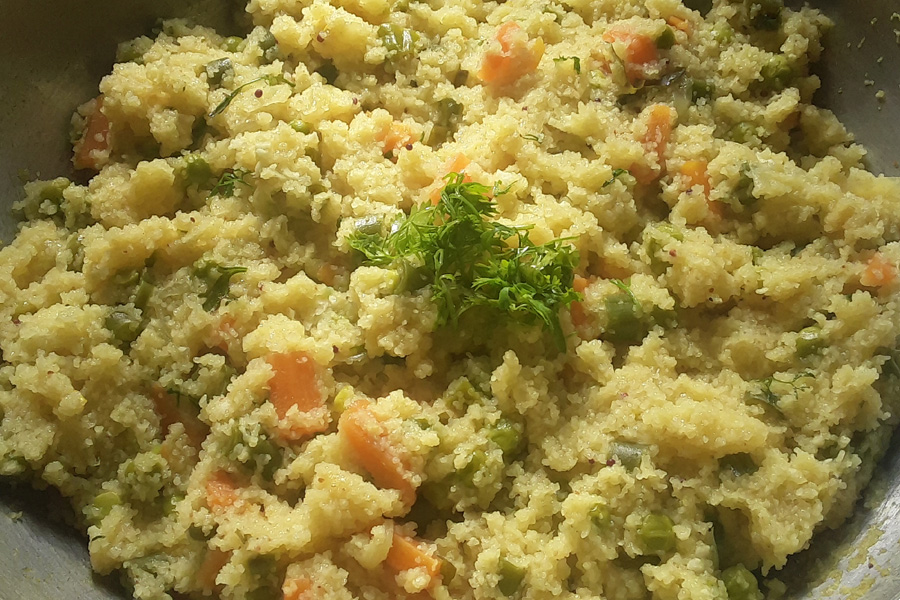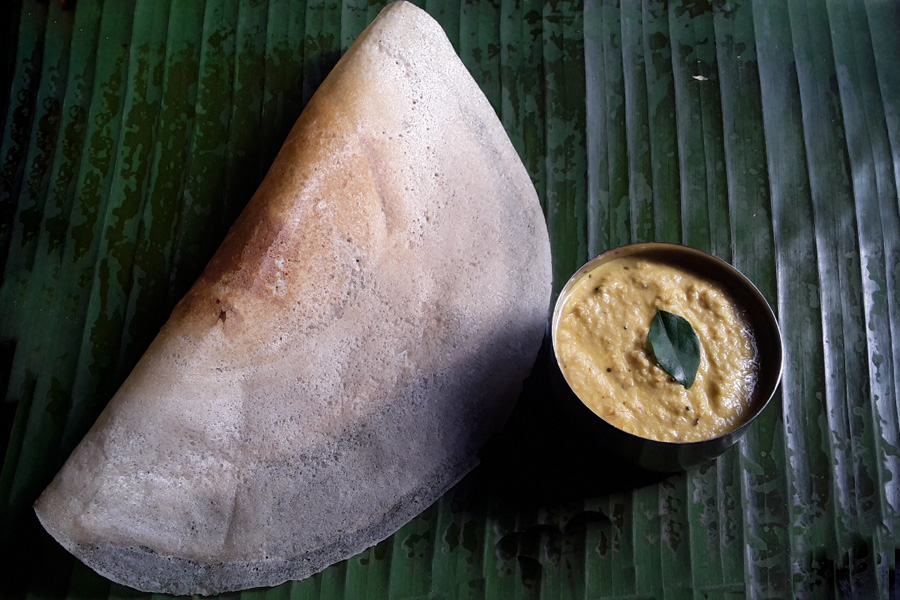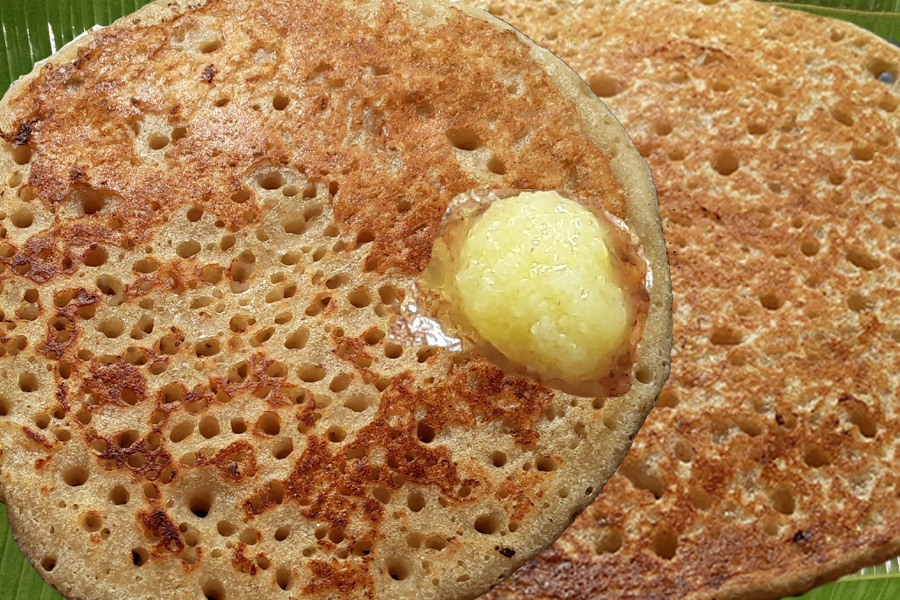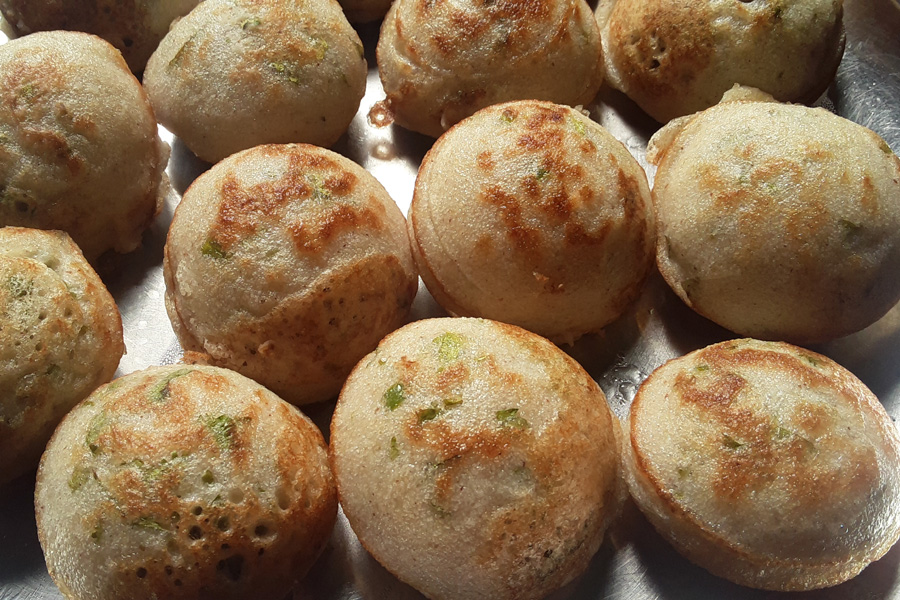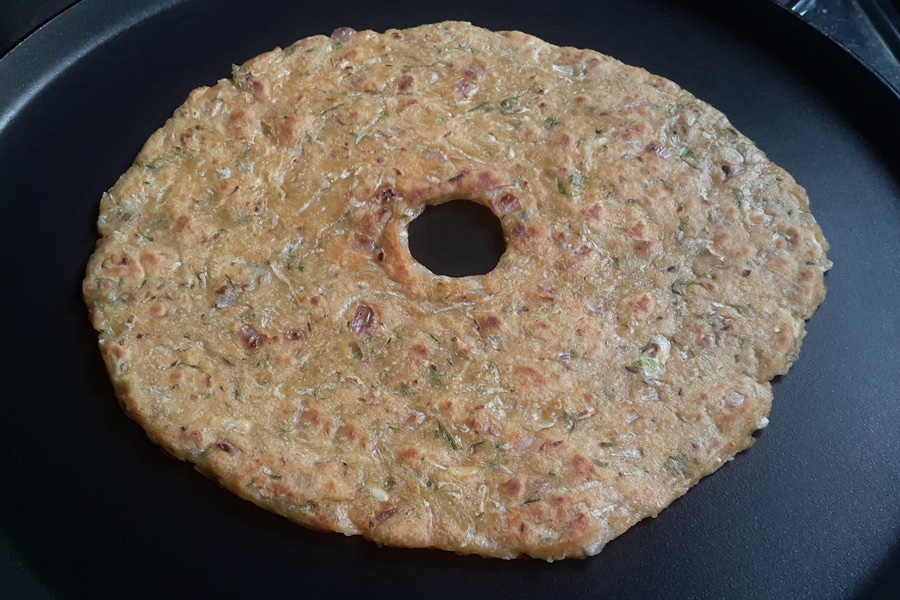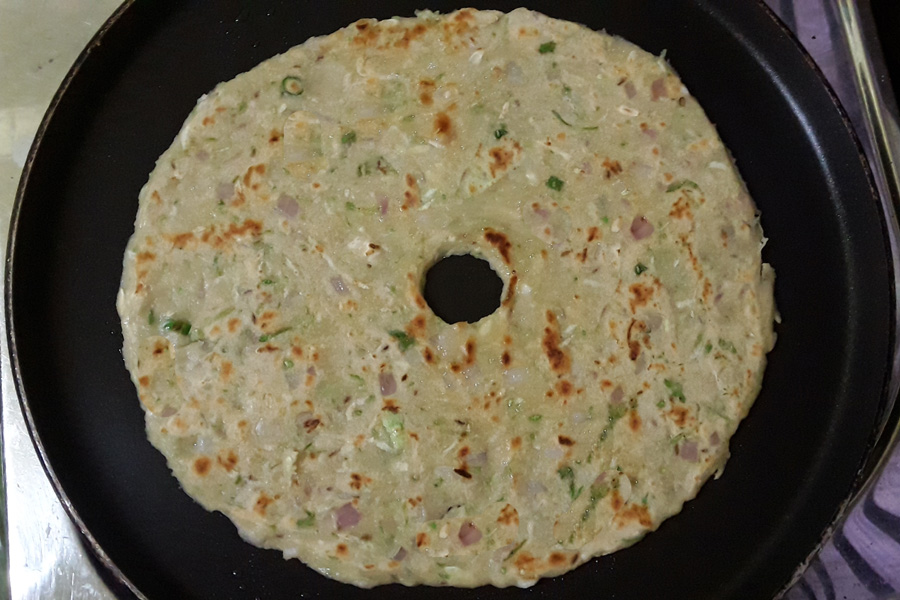Chappe Kadbu | Idli

By Leena Hegde, Puttanamane
Kadbu or Kadubu is popularly known as Idli. These are soft, fluffy, aromatic steamed cakes made with ground lentil batter and rice rava (Idli rava). Lentil used for Kadbu is husked black gram (uddina bele or urad dal). These fragrant Kadbu or idlis are made by pouring the Kadbu batter in the banana leaf mould and steamed in olden style steamer. Steaming in banana leaves gives these Kadbu the flavor and mild aroma of banana leaves.
In Havyaka language this banana leaf cup or mould is called Kotte. And this is the traditional way of making Idli among havyakas. This tastes different from the idlis steamed in the idli stand.
Rice rava (rice semolina) should be coarse. Coarse rice rava is called Akki Nucchu in havyaka language. Akki means rice and Nucchu means coarse rava. As a child I have seen making of Akki Nucchu at home using traditional manual stone grinder. Though using mixer, some people still make rice rava at home as the rice rava available in the market is made of polished rice and not very coarse.
Coarse rice rava or Akki Nucchu that is available in the market is used in this recipe. This Akki Nucchu is coarser than regular idli rava. This recipe yields 5 small or 3 medium kotte of kadbu, which can be served to 4 to 5 people. This traditional soft, spongy Kadbu is not only breakfast dish, but can also be enjoyed with lunch and dinner as well.


Prep time
9 hrs
Cook time
30 mins
Cool off time
10 mins
Total time
9 hrs 40 mins
Course
Breakfast
Diet
Vegan, Vegetarian
Difficulty level
Moderate
Servings
5 kotte
Ingredients
-
1 cup husked black gram – whole or split (uddina bele or urad dal)
- 3/4 cup coarse rice rava
- Salt as required
- Water as required
Cookware / Utensils
-
Steamer
- 5 small or 3 medium sheets of banana leaf
- Bowl
- Spoon
Instructions
Instructions
Making Kadbu batter
- Take 1 cup husked black gram (uddina bele or urad dal) in a bowl. Rinse the lentils 3 to 4 times or until clean in fresh water and then soak in water for 3 to 4 hours.
- Take 3/4 cup coarse rice rava in a thick pan. Please note that I am using coarse rice rava. If you are using regular fine idli rava, take 1 cup of idli rava. (See notes for proportion details.)
- Dry roast the rice rava till it turns hot on medium heat. No need to brown it. Keep stirring and switch off once it turns hot and aromatic. This takes 4 to 6 minutes depending on the thickness of the pan and the flame. Let it cool.
- After 3 or 4 hours, drain the water from the soaked lentils. Add the lentils in a mixer jar or grinder.
-
Add water as required and grind to a smooth and fluffy batter.
Add water in steps. I added 1.25 cups water to grind 1 cup of husked black gram in mixer. - Take the batter in a large bowl. The consistency of the batter should be thick but easily flowing.
- Now take the roasted rice rava in a large bowl and rinse it a couple of times or until it is clean.
- Take some portion of rice rava in your palm and squeeze it to take out all the water. Add this squeezed rice rava to the lentil batter. This way squeeze the entire rice rava and add to the lentil batter.
- Mix very well with a spoon or spatula making sure that there are no lumps. Cover the batter and keep aside. Let it ferment for 8 to 9 hours. (See notes for fermentation details.)
Making banana leaf kotte (mould / cup)
- Take 3 medium or 5 small sheets of banana leaf. Keep the thread (banana leaf fiber) when you cut the banana leaf.
- Clean them very well with water or with wet cloth.
- Now take each banana leaf sheet and pass them over low flame (one sheet at a time), moving them constantly, until they soften and pliable.
- Then, take one banana leaf sheet and roll it to form a hollow cylinder.
- Tie at one end with banana leaf fiber thread.
- Make kotte or cups with all 3 medium or 5 small sheets of banana leaf. If banana leaves are very large 2 cups are sufficient.
Make / steam Kadbu
- Now take the fermented kadbu batter, add salt and mix well.
- Take a steamer and place a stand in it. Pour water to the height of the stand placed inside the steamer.
- Place a plate on the stand and heat the steamer on a low to medium heat.
- Place a piece of banana leaf on top of the plate, if you have one. (Optional)
- Now take one banana leaf kotte or cup and place it in a container.
- Gently pour the kadbu batter with a spoon in the banana leaf kotte or cup. Fill batter only 3/4 of the kotte.
- Leave some space and tie at the other end of the kotte. A little space is left as kadbu will increase in size once cooked.
- Place the kotte in the steamer.
- This way pour the remaining batter in 3 or 5 kotte or cups and keep them in the steamer.
- Cover with a lid and steam kadbu for 20 to 30 minutes on high flame. I have used thick steamer and takes 30 minutes to steam.
- Once done, switch off the heat and wait for 10 minutes. Then remove the lid and take out each kotte.
- Remove the leaves gently. There would be some kadbu crumbs stuck on the leaves. Scrape them as well.
- Serve kadbu hot or warm with coconut chutney or huli (samber / lentil-vegetable stew).
Step by step guide
How to make Chappe Kadbu | Idli
Making Kadbu batter
1. Take 1 cup husked black gram (uddina bele or urad dal) in a bowl. Rinse the lentils 3 to 4 times or until clean in fresh water and then soak in water for 3 to 4 hours.

2. Take 3/4 cup coarse rice rava in a thick pan. Please note that I am using coarse rice rava. If you are using regular fine idli rava, take 1 cup of idli rava. (See notes for proportion details.)

3. Dry roast the rice rava till it turns hot on medium heat. No need to brown it. Keep stirring and switch off once it turns hot and aromatic. This takes 4 to 6 minutes depending on the thickness of the pan and the flame. Let it cool.

4. After 3 or 4 hours, drain the water from the soaked lentils. Add the lentils in a mixer jar or grinder.

5. Add water as required and grind to a smooth and fluffy batter.
Add water in steps. I added 1.25 cups water to grind 1 cup of husked black gram in mixer.

6. Take the batter in a large bowl. The consistency of the batter should be thick but easily flowing.

7. Now take the roasted rice rava in a large bowl and rinse it a couple of times or until it is clean.

8. Take some portion of rice rava in your palm and squeeze it to take out all the water. Add this squeezed rice rava to the lentil batter. This way squeeze the entire rice rava and add to the lentil batter.

9. Mix very well with a spoon or spatula making sure that there are no lumps. Cover the batter and keep aside. Let it ferment for 8 to 9 hours. (See notes for fermentation details.)

Making banana leaf kotte (mould / cup)
10. You can make banana leaf kotte beforehand and keep it or can make before making kadbu.
Take 3 medium or 5 small sheets of banana leaf. Keep the thread (banana leaf fiber) when you cut the banana leaf.

11. Clean them very well with water or with wet cloth.

12. Now take each banana leaf sheet and pass them over low flame (one sheet at a time), moving them constantly, until they soften and pliable.
Observe that as soon as you pass banana leaf over a flame it starts changing the colour and will become shinier. Move the leaf constantly and quickly and do not burn.

13. Then, take one banana leaf sheet and roll it to form a hollow cylinder.

14. Tie at one end with banana leaf fiber thread.

15. Make kotte or cups with all 3 medium or 5 small sheets of banana leaf. If banana leaves are very large 2 cups are sufficient.
You can also make and keep a few additional cups handy, if you have more banana leaves.

Make / steam Kadbu
16. Now take the fermented kadbu batter, add salt and mix well.

17. Take a steamer and place a stand in it. Pour water to the height of the stand placed inside the steamer.

18. Place a plate on the stand and heat the steamer on a low to medium heat.
Make sure water at the bottom is NOT overflowing on the plate.

19. Place a piece of banana leaf on top of the plate, if you have one. (Optional)

20. Now take one banana leaf kotte or cup and place it in a container.

21. Gently pour the kadbu batter with a spoon in the banana leaf kotte or cup. Fill batter only 3/4 of the kotte.

22. Leave some space and tie at the other end of the kotte. A little space is left as kadbu will increase in size once cooked.

23. Place the kotte in the steamer.
This way pour the remaining batter in 3 or 5 kotte or cups and keep them in the steamer.

24. Cover with a lid and steam kadbu for 20 to 30 minutes on high flame. I have used thick steamer and takes 30 minutes to steam.
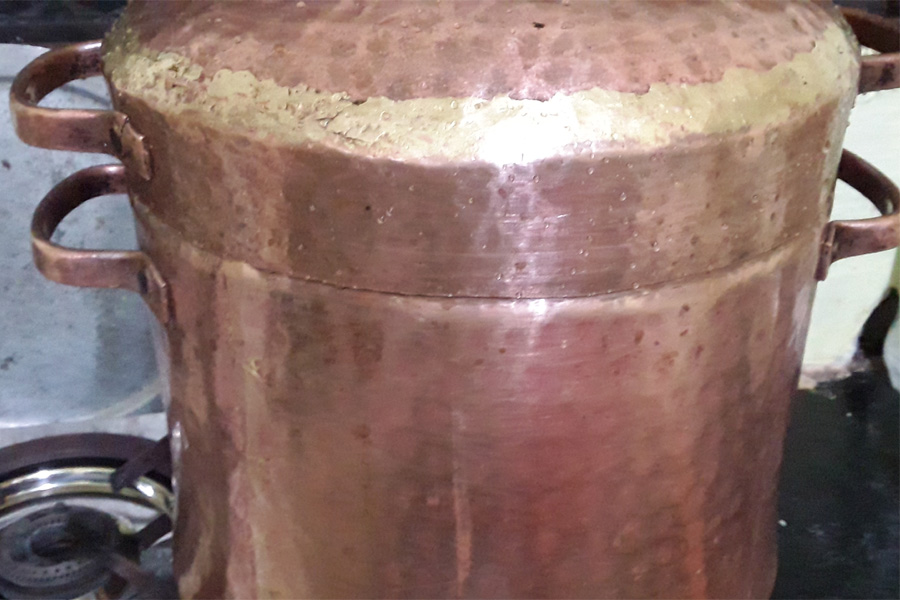
25. Once done, switch off the heat and wait for 10 minutes. Then remove the lid and take out each kotte.

26. Remove the leaves gently. There would be some kadbu crumbs stuck on the leaves. Scrape them as well.

27. Serve kadbu hot or warm with coconut chutney or huli (samber / lentil-vegetable stew).

28. You can also make medium or large kadbu into pieces before serving.
Look at the soft spongy texture of the kadbu.

29. Kadbu can also be served with liquid jaggery & butter, and chutneypudi (chutney powder).
Notes
-
Kadbu batter: Kadbu batter consistency should be thick but easily flowing. Do not over ferment the batter. Over fermented batter will be very sour and may give you an odd odor. In summer, if you are keeping the batter for overnight fermentation, make sure you add only 2 tablespoons roasted rice rava to the lentils batter. And add the rest of the rice rava next morning or before steaming the kadbu.
-
Proportion: If a mixer is used to grind the lentils, the proportion is 1: 3/4 ratio of black gram to rice rava.
If using stone grinder, use 1:1 ratio of black gram to rice rava.
If using mixer and fine idli rava, , use 1:1 ratio of black gram to idli rava.
If using stone grinder and fine idli rava, , use 1:1.25 ratio of black gram to idli rava.
And again, softness and fluffiness of the kadbu also depends on the variety and quality of the lentils and rice rava. After 2 to 3 trials you will find your own ratio.
- Fermentation: When kadbu is made for regular day breakfast, batter is fermented overnight. That adds up 12 to 14 hours of fermentation. If kadbu is done on any religious occasion, then batter has to be prepared on the same day. So, there would be less time for batter to settle, say about 3 to 4 hours. Still this kadbu would be soft if the ingredient proportion and the batter consistency is right. Normal range is 8 to 9 hours for kadbu batter to ferment. Again, fermentation time will vary depending on the climate and room temperature conditions.
- Making banana leaf kotte: You can make banana leaf kotte or cup beforehand and keep, i.e. a day before. Do not keep it for too many days as banana leaf will become dry, especially in dry weather, and it will get spoiled in humid weather.
- Steaming time: With banana leaf cup, kadbu takes slightly longer to steam than regular idlis. So steam really well. Steaming time depends on size, thickness of the steamer used and the heat applied. After 20 minutes (or 30 minutes if the steamer is thick) you can check if the kadbu are done by inserting a knife or skewer. There should be no stickiness on the knife or skewer.
